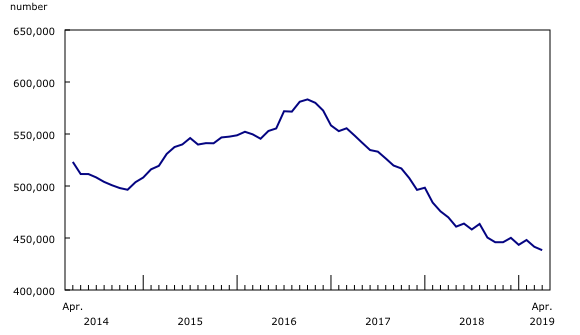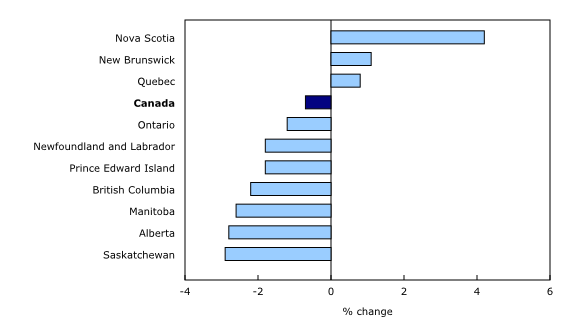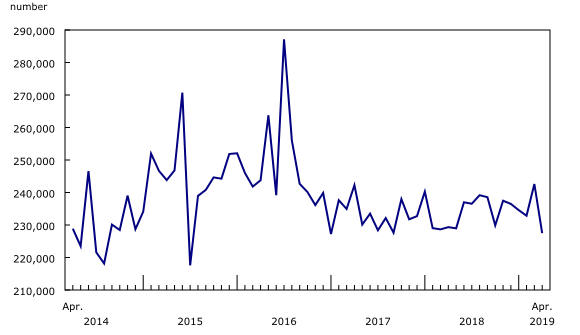Employment Insurance, April 2019
Archived Content
Information identified as archived is provided for reference, research or recordkeeping purposes. It is not subject to the Government of Canada Web Standards and has not been altered or updated since it was archived. Please "contact us" to request a format other than those available.
Released: 2019-06-20
In April, 438,300 people received regular Employment Insurance (EI) benefits, little changed from March.
The number of beneficiaries decreased in seven provinces, most notably in Saskatchewan (-2.9%), Alberta (-2.8%) and Manitoba (-2.6%). In contrast, there were increases in Nova Scotia (+4.2%) and New Brunswick (+1.1%), while there was little change in Quebec.
On a year-over-year basis, the number of EI beneficiaries in Canada decreased by 31,600 (-6.7%), with declines in all provinces. At the same time, employment has been trending up, increasing 2.3% over the 12 months to April.
In general, variations in the number of beneficiaries can reflect changes in the circumstances of different groups, including those becoming beneficiaries, those going back to work, those exhausting their regular benefits, and those no longer receiving benefits for other reasons.
Provincial and sub-provincial overview
In Saskatchewan, 15,500 people received regular EI benefits in April, down 2.9% from March. There were notable declines in the census metropolitan area (CMA) of Saskatoon (-5.1%) and in areas outside the CMAs and census agglomerations (CAs) (-2.4%). On a year-over-year basis, the number of beneficiaries in Saskatchewan declined 11.6%, the largest decrease among the provinces. According to the Labour Force Survey (LFS), employment in the province increased by 2.6% over the same period, while the unemployment rate decreased by 1.0 percentage point to 5.4%.
There were 51,600 Albertans receiving regular EI benefits in April, down 2.8% from March. There were decreases across the province, most notably in the areas outside of the CMAs and CAs (-3.8%) and in the CMA of Calgary (-3.7%). At the provincial level, there were fewer beneficiaries who had last worked in natural resources, agriculture and related production occupations (-12.4%). Compared with April 2018, the number of regular EI recipients was down 9.6% in the province.
In April, there were 15,500 regular EI beneficiaries in Manitoba, down 2.6% from the previous month. There were fewer beneficiaries in the CMA of Winnipeg (-3.1%) and in the areas outside the CMA and CAs (-2.2%). On a year-over-year basis, 1.9% fewer people received regular benefits.
The number of beneficiaries in British Columbia declined 2.2% to 40,600. Decreases across most of the province, notably in the CMA of Kelowna (-7.7%) and in the areas outside the CMAs and CAs (-4.4%), were partially offset by an increase in the CMA of Vancouver (+1.7%). Compared with April 2018, the number of beneficiaries in the province decreased by 5.3%.
There were 7,600 EI recipients in Prince Edward Island in April, 1.8% fewer than in March. This was the fourth consecutive monthly decrease, with declines spread across the province. Compared with 12 months earlier, there were 4.5% fewer beneficiaries in April.
In Newfoundland and Labrador, the number of people receiving regular EI benefits decreased by 1.8% to 33,200, due to fewer beneficiaries in areas outside of the CMA and CAs (-2.5%). Compared with April 2018, there were 10.9% fewer recipients in Newfoundland and Labrador. At the same time, according to the LFS, the unemployment rate in the province decreased 2.8 percentage points to 11.7%.
In April, 113,400 Ontarians received regular EI benefits, down 1.2% compared with March. Most of the decrease came from the CMAs, with declines in Oshawa (-7.3%), London (-6.4%), Hamilton (-3.7%) and Toronto (-1.6%) partially offset by increases in Windsor (+4.7%) and the Ontario part of the Ottawa–Gatineau CMA (+2.6%). Compared with 12 months earlier, the number of beneficiaries in the province was down 6.3%, the 21st consecutive month of year-over-year declines.
The number of beneficiaries in Nova Scotia was up 4.2% to 26,300 in April, partially offsetting a decline in March. The increase in April was spread across the province. On a year-over-year basis, the number of EI recipients declined 3.5%. According to the LFS, the unemployment rate increased 0.7 percentage points to 6.9% in April, following a downward trend that started in September 2018.
In New Brunswick, there were 28,600 regular EI beneficiaries in April, 1.1% more than in March. Most of the increase took place outside the CMAs and CAs (+1.1%). There were 1.2% fewer regular EI recipients in the province in April compared with 12 months earlier.
There was little change in the number of people receiving EI benefits in Quebec in April, at 103,400. The number of beneficiaries in the province had been trending downward since September 2018. On a year-over-year basis, there were 7.7% fewer people receiving regular EI benefits in Quebec.
Employment Insurance claims
In April, there were 227,500 claims, down 6.2% from the previous month. The number of claims provides an indication of the number of people who could become beneficiaries. Claims data pertain to initial and renewal claims received for any type of EI benefits, including special benefits.
The number of claims decreased in all provinces, most notably in Manitoba (-19.6%), Alberta (-8.4%) and Quebec (-8.2%). The decrease in Manitoba offset a similar increase in the previous month.
On a year-over-year basis, the number of claims was little changed, as decreases in seven provinces, notably Quebec (-4.5%) and Alberta (-4.4%), offset increases in Prince Edward Island (+6.4%), Ontario (+5.6%) and British Columbia (+2.7%).
Spotlight on Nunavut: 20 years of data
In April 1999, the territory of Nunavut was created as part of the Nunavut Land Claims Agreement between the Inuit and the Government of Canada. For the last 20 years, Statistics Canada has been publishing data on Nunavut, including EI statistics.
Since October 2014, Nunavut has been divided into two EI economic regions: Iqaluit and the communities outside of the capital. For the period from April 7 to May 11, 2019, the unemployment rates for EI purposes were 6.1% in the Iqaluit region and 18.9% in the rest of Nunavut. The regional unemployment rates are used to determine the number of insured hours a worker has to have worked to qualify for regular benefits.
In April 2019, 460 Nunavummiut received regular EI benefits, little changed over the previous six months, following a downward trend throughout most of 2018.
The number of recipients in April 2019 was similar to what it was 20 years earlier, in April 1999, when there were 490 recipients. There were notable increases in 2009, coinciding with the economic downturn, and in July 2016, when the duration of EI benefits was increased in some regions of the country. For more information on this topic, please visit Additional Employment Insurance regular benefits for unemployed workers in affected regions.
In April 2019, about two-thirds (67%) of those receiving regular EI benefits were men, a proportion that has remained relatively stable since comparable data became available in 1999. Also, 43% of recipients last worked in trades, transport, equipment operations and related occupations.
In addition to those receiving regular EI benefits, other Nunavummiut received special benefits (parental, maternity, and sickness benefits) and a small number received fishing benefits. On average, in 2018, close to one-third (32%) of those receiving EI benefits received special benefits, with the majority of them receiving parental benefits.
Sustainable Development Goals
On January 1, 2016, the world officially began implementation of the 2030 Agenda for Sustainable Development—the United Nations' transformative plan of action that addresses urgent global challenges over the next 15 years. The plan is based on 17 specific sustainable development goals.
Employment Insurance is an example of how Statistics Canada supports the reporting on the Global Goals for Sustainable Development. This release will be used in helping to measure the following goal:

Note to readers
Historical revision
With the June 20, 2019 release of April data, the Employment Insurance (EI) statistics were revised back to January 2000. This revision contains the following changes:
Geography boundaries have been updated from the 2011 to the 2016 Standard Geographical Classification, which mainly affects boundaries of census metropolitan areas (CMAs) and census agglomerations (CAs).
Occupations have been updated from the 2011 to the 2016 National Occupation Classification (NOC). This change had no effect on the estimates published at the 3-digit NOC level.
The seasonally adjusted series of EI statistics were revised to reflect the most recent seasonal factors.
To preserve consistencies across time despite all of the above changes, all EI data series have been the subject of an historical revision going back to January 2000.
Concepts and methodology
The analysis presented here focuses on people who received regular EI benefits related to job loss. Claims data pertain to initial and renewal claims received for any type of EI benefits, including special benefits.
EI statistics are produced from administrative data sources provided by Service Canada and Employment and Social Development Canada. These statistics may, from time to time, be affected by changes to the Employment Insurance Act or administrative procedures.
Regular EI benefits are paid to eligible individuals who lose their jobs and who are available for and able to work, but cannot find a job. To receive EI benefits, individuals must first submit a claim.
EI statistics indicate the number of people who received EI benefits, and should not be confused with Labour Force Survey (LFS) data, which provide estimates of the total number of unemployed people. There is always a certain proportion of unemployed people who do not qualify for benefits. Some unemployed people have not contributed to the program because they have not worked in the past 12 months or their employment was not insured. Other unemployed people have contributed to the program but do not meet the eligibility criteria, such as workers who left their job voluntarily or those who did not accumulate enough hours of work to receive benefits.
All data in this release are seasonally adjusted. For more information on seasonal adjustment, see Seasonally adjusted data – Frequently asked questions.
Excluding the Spotlight, numbers in the Daily text are rounded to the nearest hundred.
The number of regular EI beneficiaries and the number of claims received for the current and previous month are subject to revision.
The number of beneficiaries is a measure of all people who received EI benefits from April 14 to 20. This period coincides with the reference week of the LFS. However, claims data are for the entire month.
Geographical definitions
A CMA or a CA is formed by one or more adjacent municipalities centered on a population centre. A CMA must have a total population of at least 100,000. A CA must have a population of at least 10,000. See Standard Geographical Classification 2016 – definitions for more information.
Next release
Data on EI for May will be released on July 18.
Products
More information about the concepts and use of Employment Insurance statistics is available online in the Guide to Employment Insurance Statistics (73-506-G).
Contact information
For more information, contact us (toll-free 1-800-263-1136; 514-283-8300; STATCAN.infostats-infostats.STATCAN@canada.ca).
To enquire about the concepts, methods or data quality of this release, contact Bertrand Ouellet-Léveillé (613-864-6641; bertrand.ouellet-leveille@canada.ca), Labour Statistics Division.
- Date modified:






